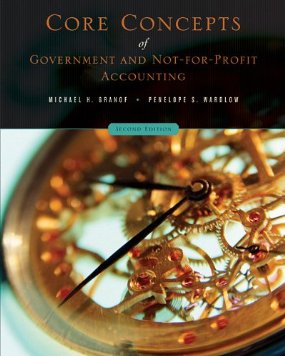Test Bank for Core Concepts of Government and Not-for-Profit Accounting, 2nd Edition, Granof,
$55.00 Original price was: $55.00.$29.99Current price is: $29.99.
Test Bank for Core Concepts of Government and Not-for-Profit Accounting, 2nd Edition, Granof,
Instant download Test Bank for Core Concepts of Government and Not-for-Profit Accounting, 2nd Edition, Granof pdf docx epub after payment.

Product details:
- ISBN-10 : 9780471737926
- ISBN-13 : 978-0471737926
- Author: Michael H. Granof (Author), Penelope S. Wardlow (Author)
Building on the success of Government and Not-For-Profit Accounting, 2e, Michael Granof and Penelope Wardlow’s Core Concepts of Government and Not-For-Profit Accounting 2nd Edition presents a concise, accessible, user-oriented look at the unique features of governmental and not-for-profit accounting. The text helps students understand the “why” of accounting requirements and how financial statements may be interpreted and used by a variety of interested parties, such as future managers, bond analysts, and members of legislatures and governing boards.
Table of contents:
Chapter 1 The Government and Not-for-Profit Environment.
How Do Governments and Not-for-Profits Compare with Other Businesses?
What Other Characterisitics of Governments and Not-for-Profits Have Accounting Implications?
What Are the Overall Purposes of Financial Reporting?
Who Are the Users and What Are the Uses of Financial Reports?
What Are the Specific Objectives of Financial Reporting As Set Forth by the GASB and the FASB?
Do Differences in Accounting Principles Really Matter?
Who Establishes Generally Accepted Accounting Principles?
Chapter 2 Fund Accounting.
What is a Fund?
What Characterizes Funds?
What Are the Main Types of Governments’ Funds?
What’s Notable about Each Type of Governmental Fund?
What’s Notable about Each Type of Proprietary Fund?
What’s Notable about Each Type of Fiduciary Fund?
How Do the Funds of Not-for-Profits Differ from Those of Governments?
Chapter 3 Government Financial Reporting.
How Can Funds Be Combined and Consolidated?
What is a GASB Statement No. 34?
What Are the Required Basic Financial Statements?
What Are the Governmental-Wide Financial Statements?
What Are the Fund Financial Statements?
What Are Notes and Required Supplementary Information?
What Additional Information Do Governments Typically Report?
Chapter 4 Governmental Activities—Revenues.
Why and How Do Governments Use the Modified Accrual Basis of Accounting?
What Triggers Revenue Recognition for Nonexchange versus Exchange Transactions?
What Are the Main Types of Nonexchange Revenues?
How Should Property Taxes and Other Imposed Nonexchange Revenues Be Accounted for?
How Should Sales and Income Taxes and Other Derived Tax Revenues Be Accounted for?
How Should Grants and Similar Nonexchange Revenues Be Accounted for?
How Should Sales of General Capital Assets Be Accounted for?
How Should Investment Gains and Losses Be Accounted for?
How Should External Investment Pools Be Accounted for?
How Should Interest on Investments Be Accounted for?
How Should Licenses, Permits and Other Exchange or”Exchange-Like” Transactions Be Accounted for?
How Should Governments Report Revenues in Thier Government-Wide Statements?
Chapter 5 Governmental Activities—Expenditures and Expenses.
How Is the Accrual Concept Modified for Exchange Expenditures?
How Should Wages and Salaries Be Accounted for?
How Should Compensated Absences Be Accounted for?
How Should Pensions and Other Post-Employment Benefits Be Accounted for?
How Should Claims and Judgments Be Accounted for?
How Should the Acquisition and Use of Materials and Supplies Be Accounted for?
How Should Prepayments Be Accounted for?
How Should Capital Assets Be Accounted for?
How Should Interest and Principal on Long-Term Debt Be Accounted for?
How Should Nonexchange Expenditures Be Accounted for?
How Should Interfund Activities Be Accounted for?
What Constitute Other Financing Sources and Uses?
How Should Governmental Fund Operating Statements Be Accounted for?
What Is the Significance of the Governmental Fund Financial Statements?—An Overview.
Chapter 6 Governmental Activities—Capital Projects and Debt Service.
How Do Governments Account for Capital Projects?
How Do Governments Account for Resources Dedicated to Debt Service?
How Do Governments Handle Special Assessments?
Why is Arbitrage a Concern of Governments?
How Can Governments Benefit from Debt Refundings?
Realizing Economic Gains—Exceptions to the General Rule.
Chapter 7 Governmental Activities—Capital Assets and Investments in Marketable Securities.
What Accounting Practices Do Governments Follow for General Capital Assets?
Why and How Should Governments Report Infrastructure?
What Are the Limitations of Information Reported about General Capital Assets?
How Should Governments Account for Assets that Are Impaired?
What Issues Are Critical As to Investments in Marketable Securities and Other Financial Instruments?
Chapter 8 Governmental Activities—Long-Term Obligations.
Why Is Information on Long-Term Debt Important to Statement Users?
Can Governments Go Bankrupt?
How Do Governments Account for General Long-Term Obligations?
What Constitutes Long-Term Debt of Governmental Activities?
What Other Information Do Users Want to Know about Outstanding Debt?
What Are Bond Ratings and Why Are They Important?
Chapter 9 Business-Type Activities and Internal Services.
Why Do Governments Engage in Business-Type Activities?
What Are Proprietary Funds?
Should Governments Account for Proprietary Funds Differently than Governmental Funds?
What Are the Three Basic Financial Statements of Proprietary Funds?
What Accounting Issues Are Unique to Enterprise Funds?
What Are Internal Service Funds, and How Are They Accounted for?
What Special Problems Are Created in Accounting for Self-Insurance?
How Are Proprietary Funds Reported?
What Do Users Want to Know about Revenue Debt?
Chapter 10 Permanent Funds and Fiduciary Funds.
What Are Endowments?
What Are Permanent Funds and How Are They Distinguished from Fiduciary Funds?
Why Should All Endowments Be Accounted for on a Full Accrual Basis—and Why Aren’t They?
Should Investment Gains Be Considered Net Additions to Endowment Principal or Expendable Income?
How Should Permanent Fund Investment Losses Be Accounted for?
How Are Endowment Transactions Recorded and Reported?
What Financial Statements Are Required for Fiduciary Funds?
What Are Pensions and Why Are They Important?
How Should an Employer Account for its Pension Contributions?
How Should a Defined Benefit Pension Plan Be Accoutned for?
How Should Postemployment Benefits Other Than Pensions (OPEB) Be Accounted for?
What Accounting Issues Do Investment Trust Funds Present?
What Accounting Issues Do Agency Funds Present?
Chapter 11 Issues of Reporting and Disclosure.
How Can a Government Prepare Government-Wide Statements from Fund Statements?
Why Is the Reporting Entity an Issue for Governments?
What Criteria Have Been Established for Government Reporting Entities?
What Is Included in a Government’s CAFR?
What Are the Reporting Requirements for Colleges, Universities, and Other Special-Purpose Governments?
Chapter 12 Not-for-Profit Organizations.
Who’s in Charge?
What Should the Form and Content of Financial Statements Be?
What Are Contributions, and How Should Pledges Be Accounted for?
When Should Use-Restricted Contributions Be Recognized?
Should Contributions of Services Be Recognized?
Should Contributions of Collection Items Be Recognized As Revenues?
When Should Conditional Promises Be Recognized?
How Should “Pass-Through” Contributions Be Accounted for?
When Should Gains and Losses on Investments Be Recognized?
How Should Organizations Account for Gains and Losses on Endowments?
How Should Depreciation Be Reported?
What Issues Does a Not-for-Profit Face in Establishing Its Reporting Entity?
Chapter 13 Special Issues for Not-for-Profit Health Care Providers and Institutions of Higher Education.
What Unique Issues Do Health Care Providers Face?
What Unique Issues Do Colleges and Universities Face?
Chapter 14 Auditing Governments and Not-for-Profit Organizations.
How Do Audits of Governments and Not-for-Profits Differ from Those of Businesses?
How Has the Yellow Book Influenced Governments and Not-for-Profit Auditing?
What Types of Audits Do Governments Conduct?
What Levels of Standards Are Applicable to All Engagements?
What Are the Key Differences between Government and Nongovernment Financial Audit Standards?
How Have the Single Audit Act and Other Pronouncements Influenced Auditing?
What Approach Do Auditors Take in Performing Single Audits?
What Are Performance Audits?
What Unique Ethical Issues Do Government and Not-for-Profit Accounting and Auditing Present?
Chapter 15 Financial Analysis.
How Can a Government’s Economic Condition Be Assessed?
Why Is It Important to Assess Likely Future Changes?
Why Is It Important to Evaluate Accounting and Reporting Practices?
What Ratios and Other Indicators May Be Useful?
How Can a Not-for-Profit’s Economic Condition Be Assessed?
How Can Conclusions Be Drawn?
Glossary.
Index.
People also search:
Core Concepts of Government and Not-for-Profit Accounting, 2nd Edition
Core Concepts of Government and Not-for-Profit Accounting, 2nd Edition pdf
Core Concepts of Government and Not-for-Profit Accounting
what is nonprofit accounting
nonprofit accounting principles
government and not-for-profit accounting concepts and practices











